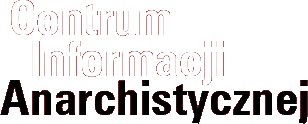ANNOUNCEMENT BY THE POLYTECHNIC OCCUPATION (24.12.08)
The Occupation of the Polytechnic ended at midnight of the 24th of December – The struggle continues…
ANNOUNCEMENT BY THE POLYTECHNIC OCCUPATION
Immediately after the murder of Alexandros Grigoropoulos by the special police guard Ep. Korkoneas and the first clashes in the streets of Exarchia, the Polytechnic university was occupied and turned into a focus for the expression of social rage. Being a space historically and symbolically connected in the living memory ofthe rebels and of a big part of society with the struggle against Authority -from the period of dictatorship until today’s modern totalitarian democracy-, the Polytechnic became the place where hundreds of people gathered spontaneously: comrades, youth and workers, jobless, pupils, immigrants, students…
The fights with the forces of repression and the flaming barricades in the surrounding streets became the spark of a revolt that spread with spontaneous demonstrations in the city, the occupation of the Economics University and the Law School, with attacks against state and capitalist targets in the centre and neighborhoods of Athens and in most cities across the country.
The following days, with demonstrations of thousands of people ending up in riots and attacks against banks, ministries and big department stores, with occupations of schools and public buildings, with young children besieging and assaulting policestations, the riot police guarding Koridallos prison and the Parliament, the revolt became generalized; this revolt that was triggered by the murder of A. Grigoropoulos and exploded by the immediate reaction of hundreds of comrades to that event of the widespread state violence, inspiring actions of rage and solidarity beyond the borders, all over the world.
This revolt that was simmering in the conditions of a generalized attack by the state and the bosses against society, growing in the reality of the everyday death of freedom and dignity that is reserved for the oppressed people by the increasing exclusion, poverty, exploitation, repression and control. This revolt that was persistently being “prepared”, even in the darkest times of state and fascist terrorism, through every small or big gesture of resistance against submission and surrender, keeping open the way for many more people to meet in the streets, just like it happened during these days.
In this explosive social reality, the occupied Polytechnic became a point of reference for a direct confrontation with the state, in all forms and with allpossible means, through consecutive insurrectionary events that burned down the order and security of the bosses, smashing the fake image of social consent to their murderous intentions. It became a place where rebellious social and political subjects met and influenced one another, through the general assemblies and their daily presence in the occupation. It functioned as a base for counter-information, through communiqués and posters, its blog and radio station, and with the PA system sending the messages and the news of the ongoing revolt. And it also gave life to political initiatives of resistance, like the call made by the Polytechnic occupation assembly for a global day of action on the 20th of December –which resulted in coordinated mobilizations in more than 50 cities in different countries, and in which the Polytechnic occupiers participated by calling for a gathering in the place where A. Grigoropoulos was murdered-, like the concert held on the 22nd of December for solidarity and financial support to the hostages of the revolt, and the call for participation in the prisoner solidarity demonstration that was organized by comrades who took part in the open assembly of the occupied GSEE (General Workers’ Confederation).
As a stable, for 18 days, point of the revolt that expanded, the occupied Polytechnic was a continuous call of insubordination to the people resisting all over the world, and a permanent sign of solidarity to the hostages taken by the state from within this struggle. It became the territory we used in order to diffuse the message of solidarity between the oppressed, of self-organisation and of a social and class counter-attack against the world of Authority, its mechanisms and its symbols. These elements and values of the struggle created the ground for the oppressed to meet in rebellion, armed our consciences and, for the first time maybe, became so widely impropriated by so many people of different age and different nationalities; people with whom anarchists and anti-authoritarians shared the same slogans against the police, the same words, the same practices of struggle, the same rage against those who are looting our lives, and, many times, the same vision for a world of freedom, equality and solidarity.
For this reason, repression was not only expressed in the form of police brutality, arrests and imprisonment of demonstrators, but also with an intense ideological attack launched by all sides of the political system which saw its foundations trembling when repression, in which it is based, not only was unable to restrain the waves of revolt, but, contrary, it was the one that caused them in the first place. This ideological attack selectively targeted anarchists, as a political and unmediated part of the revolted, exactly because of the impact their words and actions had, and because of the danger that is presented for the state when they communicate and coordinate with the thousands of the oppressed.
In this context, there was an hysterical effort to divide the revolted in “good pupils” on one hand, “evil hooded anarchists – ‘koukouloforoi’” or“immigrant looters” on the other, as well as the good old myth about provocateurs, in order to manipulate the anger for the assassination, to exhaust the social explosion, to criminalize, isolate and crush the steady points of reference of this revolt [This is, by the way, the same rhetoric of repression that led to the murder of A. Grigoropoulos, as it is responsible for recognizing specific political-social milieus, spaces and people as the “enemy within” on which state violence should be“legitimately” enforced].
In this effort made by the state, the continuous targeting of the Polytechnic was included on a daily basis, with statements made by politicians and a slandering campaign by the mass media. After the hours of clashes in Exarchia and around the Polytechnic during the night of December 20, the state, in the face of the public prosecutor, threatened to proceed to a police raid, after suspending the academic asylum in the campus, despite the disagreement of the university authorities, in order to suppress the revolt by attacking one of the first places where it hadstarted.
Their intentions were defeated because of the refusal of the occupiers to obey to any ultimatum, their decisiveness to defend this political and social territory as apart of the revolt, their open call to people to come and support the occupation with their presence and by proceeding to the planned prisoner solidarity gig on the 22nd of December which gathered hundreds of people at the Polytechnic.
The threats for an immediate eviction returned stronger the following day, December23, when, while the assembly was discussing the end of the occupation, we were informed by political and academic figures that the ministry of Interior and the police are demanding our immediate exit from the campus otherwise the cops would invade. The reply of the occupiers was that the Polytechnic does not belong neither to the ministry not to police for us to surrender to them; it belongs to the people of the struggle who decide on what to do based exclusively on criteria of the movement and do not accept blackmails and ultimatums by the assassins. This way the Polytechnic occupation was prolonged for one more day, and called to the demo which was realized in the center of Athens for solidarity with the arrested.
No repressive project and no ideological attack managed or will manage to blackmail the return to normality and to impose social and class pacification. Nothing is the same any more! The surpassing of fear, of isolation and of the dominant social divisions, led thousands of young people, together with women and men of every age, refugees and migrants, workers and jobless to stand together in the streets and behind barricades fighting the tyrants of our life, our dignity and freedom. And this is a reality lighting with its flames the future of revolt, both its intensification and deepening, until the absolute subversion of the world of the bosses.
Because we shouted in all ways that those days belong to Alexis, to Michalis Kaltezas, to Carlo Giuliani, to Christoforos Marinos, to Michalis Prekas, to Maria Koulouri and to all comrades murdered by the uniformed assassins of the state; they aren’t though days that belong to death, but to LIFE! To life that blossoms in the struggles, in the barricades, in the revolt that continues.
Ending the Polytechnic occupation after 18 days, we send our warmest solidarity to all people who became part of this revolt in their many ways, not only in Greece but also in numerous countries of Europe, of South and North America, Asia and Australia-N.Zealand. To all those with whom we met and we will stay together, fighting for the liberation of the prisoners of this revolt, but also for its continuing until global social liberation. For a world without masters and slaves,without police and armies, without borders and prisons.
DEATH TO THE STATE – LONG LIVE ANARCHY!
IMMEDIATE RELEASE OF ALL THE ARRESTED IN THE REVOLT!
THE STRUGGLE CONTINUES!
We call to the open assembly that will take place in the Polytechnic, on Saturday, December 27 at 16.00, concerning the organization of solidarity to the arrested, which was called by comrades in the assembly of the occupied GSEE.
The Polytechnic Occupation
12/24/08






